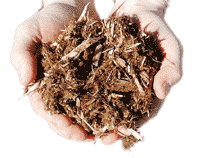|
|||||||||||
|
|||||||||||
Watch Out for TermitesBe choosy selecting soils and mulchMy caller wanted to know if it was possible to have termites living in piles of mulch. Yes, I said, but only if the mulch is made from old dead or dying trees and if the mulch had not been composted. Termites nearly always avoid burrowing in small pieces of wood most commonly found in mulch. Many old trees, however, with hollow heart wood — often cut when clearing land — are heavily infested with termites. If these trees are ground up whole by tree chippers, it is highly possible for termite eggs to survive, resulting in young termites invading the pile of ground wood waste. Unless the wood chips are properly composted to ensure elevated temperatures of 140 degrees or higher, the termite eggs will hatch, finding homes in larger pieces of wood that let them survive bagging and spreading. A good population of termites was present in a bag of mulch brought to me recently for inspection. The state of Maryland once had a law that protected buyers from purchasing bad mulches. However, that law was repealed more than 20 years ago. Now more than ever, home gardeners are bombarded with products that are no more than waste being marketed as mulch. As a result, many homeowners are killing their plants with destructive mulches or importing unwanted pests. Recently a contractor purchased a truckload of compost that turned out to be nothing more than organic, rich top soil. Compost as defined by the National Composting Council should contain a minimum of 35 percent organic matter. The truckload purchased by the contractor contained only eight percent organic matter. This means that he could not use the compost as I had specified. The moral of the story: Read labels, don’t be afraid to question and get reliable information about the products you buy. Aging Stone: Sheep Manure Will Do the JobQ I have recently repaired an ailing retaining wall in my front yard, and the new and old concrete don’t completely match. There are many spots on the old wall where moss grows, and I was hoping to add an aged look to the new by getting moss to grow on the wall’s face. Aside from waiting for nature to take its course, is there any way to cultivate moss on these vertical surfaces? –Alex Knoll, Annapolis A In England they make new stonewalls look old quickly by brushing the walls with a liquid solution of sheep manure or pig manure. This is done two to three times about a month apart. This will quickly give the wall that aged look, and within a couple of years the moss will start growing on it. However, it is not uncommon to get a good algae growth on the stones the first year. Ask Dr. Gouin your questions at [email protected]. All questions will appear in Bay Weekly. Please include your name and address. |
|||||||||||
|
|||||||||||
|
|
|||||||||||
|
© COPYRIGHT 2007 by New Bay Enterprises, Inc. All rights reserved.
|
|||||||||||


